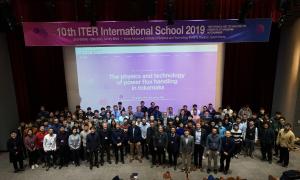It's a crisp and sunny winter week in Daejeon, South Korea—a techno hub located 140 km south of the capitol Seoul. The dynamic city, whose name derives from the old Korean term hanbat or "big land," is also the base for Korea's leading science and research university, KAIST (Korea Advanced Institute of Science and Technology). The ultra-modern KAIST campus neighbours the National Fusion Research Institute (NFRI), home of the KSTAR superconducting tokamak and the Korean Domestic Agency for ITER.
Gathered at 9:00 a.m. on Monday 21 January in the Yang Seung-Tack auditorium are more than 100 masters, graduate and postdoctoral students representing almost all the ITER partner countries, eagerly awaiting the start of five days of lectures and discussion to be offered by the 2019 edition of the
ITER International School. Co-sponsored by KAIST, the Korean Domestic Agency and NFRI, this is the tenth in the series, which alternates between sites in Aix-en-Provence, France, organized by the University of Aix-Marseille, and external hosts within the ITER Member countries.
The topic of the school this year? One of the most important challenges facing magnetic confinement fusion—how to cope with the burning plasma heat exhaust.
ITER is a transitional step, where surfaces in direct contact with the peripheral plasma will together have to remove up to about 850 MW of total power continuously, and locally up to 20,000 times the power density felt on the Earth's surface on a summer day with the Sun at its zenith.
High as these numbers are, they can be dealt with by the sophisticated, water-cooled plasma-facing components that ITER will deploy. However, the walls of commercial fusion reactors based on the ITER line will have to cope with four to five times this total power, and heat handling is already recognized as a serious potential issue that scientists and engineers must start to think about now, even before ITER fires up.
One thing common to both ITER and future tokamak reactors is that transient heat flux surges to first wall armour (mostly provoked by magnetohydrodynamic instabilities) must be strongly mitigated or completely eliminated. ITER will play a major role in showing how this can be done at reactor scale and is itself watching and working carefully with the R&D community within the ITER partners to develop and perfect the techniques which will be required.
At the School, leading specialists from research organizations within the ITER partners and from the ITER Organization delivered more than 24 hours of accessible lecture material on the science and technology of the tokamak heat exhaust challenge, interspersed with long and often stimulating discussion sessions in which students could interact directly with the speakers. Outside the auditorium, there was room for more exchange in coffee breaks or the poster sessions where students presented their own research material. Two gold and four silver poster prizes were awarded based on scores recorded by the lecturers, with the gold winners walking away with an engraved sample of ITER niobium-tin superconducting cable.
Hosted by KAIST's Wonho Choe, the 2019 ITER International School was a fine example of the value and importance of giving young scientists and engineers a taste of the stimulating, multi-disciplinary and challenging field which is magnetic fusion.


